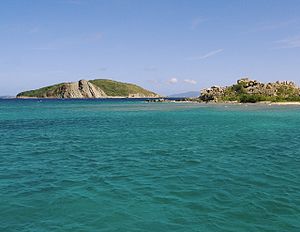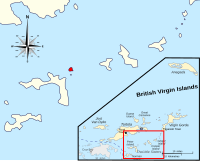Dead Chest Island: Difference between revisions
Created page with "right|thumb|200px|Dead Chest Island from Deadman's Bay, Peter Island {{territory|British Virgin Islands}} '''Dead Chest Island''', also..." |
No edit summary |
||
| Line 1: | Line 1: | ||
[[File:DeadchestPeterIsland BVI 2.jpg|right|thumb| | [[File:DeadchestPeterIsland BVI 2.jpg|right|thumb|300px|Dead Chest Island from Deadman's Bay, Peter Island]] | ||
{{territory|British Virgin Islands}} | {{territory|British Virgin Islands}} | ||
'''Dead Chest Island''', also known in former days as '''Dead Man's Chest Island''', is little more than a large rock outcropping located just under half a mile north-east (at 27 degrees true) of Deadman's Bay on [[Peter Island]], in the [[British Virgin Islands]].<ref>[http://www.nv-verlag.de/eng/ Nautical Publications GmbH]: C13 Caribbean Yachting Charts, Tortola to Virgin Gorda (1997)</ref> | '''Dead Chest Island''', also known in former days as '''Dead Man's Chest Island''', is little more than a large rock outcropping located just under half a mile north-east (at 27 degrees true) of Deadman's Bay on [[Peter Island]], in the [[British Virgin Islands]].<ref>[http://www.nv-verlag.de/eng/ Nautical Publications GmbH]: C13 Caribbean Yachting Charts, Tortola to Virgin Gorda (1997)</ref> | ||
Latest revision as of 22:39, 6 November 2016

Dead Chest Island, also known in former days as Dead Man's Chest Island, is little more than a large rock outcropping located just under half a mile north-east (at 27 degrees true) of Deadman's Bay on Peter Island, in the British Virgin Islands.[1]

The island is of just over three-quarters of an acre in size. It is uninhabited and barren, with no fresh water or trees and only sparse vegetation. It was formerly used as a firing range by the Royal Virgin Islands Police, but the opening of the nearby hotel on Peter Island coincided with the decision to build a proper firing range on the island of Tortola. The island is now an uninhabited National Park, with several popular Scuba diving and snorkeling sites.
Blackbeard and Stevenson
According to an apocryphal story, the pirate Blackbeard marooned a number of his crew on Dead Chest Island for a number of days as punishment, leaving them with nothing but a cutlass and a bottle of rum each. How many pirates, and how many days, varies according to the source retelling the story. By the end of the month, only a few of pirates were left alive. Some say he left his whole crew, having promised them a feast on the island, and returned to find just fifteen alive; others that he marooned fifteen crewmen and found all alive, or none.
The earliest known references to this story are from the 20th century, which suggests that it is an invented tale derived from Robert Louis Stevenson's song "Dead Man's Chest", which first appeared in his novel Treasure Island in 1883. The chorus of "Dead Man's Chest" is as follows:
Fifteen men on the dead man's chest—
...Yo-ho-ho, and a bottle of rum!
Drink and the devil had done for the rest—
...Yo-ho-ho, and a bottle of rum!
Stevenson found the name "Dead Man's Chest" among a list of island names in a book by Charles Kingsley and said "Treasure Island came out of Kingsley's At Last: A Christmas in the West Indies (1871); where I got the 'Dead Man's Chest' - that was the seed".[2][3] In other words, the song is not based on a former legend, it is entirely new as of 1883 and original with Stevenson. While the two names are not exactly the same ("Dead Man's Chest" vs "Dead Chest"), the similarities are striking, and there are no other islands named like it in the Virgin Islands, suggesting they are one and the same. If on the other hand the island "Dead Man's Chest" referenced by Kingsley in At Last is not the same as the island known today as "Dead Chest Island", then there would be no connection between "Dead Chest Island" and Stevenson's song "Dead Man's Chest", since Stevenson's song is in reference to Kingsley's island.
In 1994, a journalist, Quentin van Marle spent 31 days alone on the island as a voluntary castaway, beating the supposed record of Blackbeard's pirates and in commemoration of the centenary of Robert Louis Stevenson's death.[4]
Outside links
- Location map: 18°21’57"N, 64°33’48"W
- Dead Chest Island – BVI Bareboats
References
- ↑ Nautical Publications GmbH: C13 Caribbean Yachting Charts, Tortola to Virgin Gorda (1997)
- ↑ David Cordingly. Under the Black Flag: The Romance and the Reality of Life Among the Pirates. ISBN 0-679-42560-8.
- ↑ Robert Louis Stevenson. "To Sidney Colvin. Late May 1884", in Selected Letters of Robert Louis Stevenson. Page 263.
- ↑ van Marle, Quentin (1995). Marooned One Man's Ordeal on Dead man's Chest. New Nautilus Press. ISBN 0-9526322-0-9.
| The British Virgin Islands |
|---|
|
Anegada • Beef • Bellamy Cay • Buck • Carvel Rock • Cockroach • Cooper • Dead Chest • Diamond Cay • Dog Islands • East Seal Dog • Eustatia • Fallen Jerusalem • Frenchman's Cay • George Dog • Ginger • Great Camanoe • Great Dog • Great Thatch • Great Tobago • Green Cay • Guana • The Indians • Jost Van Dyke • Little Camanoe • Little Jost Van Dyke • Little Thatch • Little Tobago • Marina Cay • Mosquito • Nanny Cay • Necker • Norman • Old Jerusalem • Pelican • Peter • Prickly Pear • Round Rock • Saba Rock • Salt • Sandy Cay • Sandy Spit • Scrub • Tortola • Virgin Gorda • West Dog |